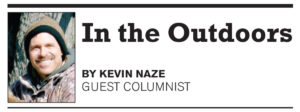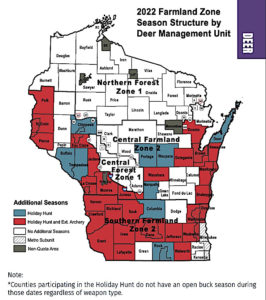
Deer hunters hoping for a snow-white backdrop for the firearm deer opener got an early Christmas gift this week across much of the state.
Snow on the ground makes spotting and tracking deer easier, and could help lead to a big increase in opening weekend success.
Some lucky hunters will also catch the tail end of the annual whitetail mating season.
All it takes is one doe-in-heat in your hunt area and the woods can come alive with buck activity.
Many of the more than half-million hunters expected to be afield will take a stand near food sources opening morning.
That could mean greens in ag fields, food plots, apple trees, acorns or — where allowed — some corn or apples scattered about to attract wildlife.
Others will focus their efforts along edge cover, fence lines or funnels leading from one woodlot to another, and some will head back into thick escape cover such as marshes, grassy potholes or deep cedar swamps.
Wherever you choose to wait out a whitetail, here’s hoping your season is a success.
To some, that might mean simply slowing the pace down and enjoying nature.
To others, it might mean cutting up and feasting on some of the leanest protein available in the wild.
Through Nov. 14, Brown County hunters had registered 873 whitetails, including 463 bucks. Other area totals included Calumet, 367; Door, 898; Kewaunee, 718; Manitowoc, 1,147; Marinette, 2,434; Oconto, 2,198; Outagamie, 1,097; and Shawano, 2,787.
The regular nine-day gun season is immediately followed by a 10-day muzzleloader deer hunt (or an extended firearm season in Brown County’s metro sub-unit) and a four-day, antlerless-only season statewide.

There’s also an antlerless-only holiday gun deer hunt in Brown, Calumet, Door, Kewaunee, Manitowoc, Oconto and Outagamie counties Dec. 24-Jan. 1.
For more on this year’s hunt, download the Hunt Wild app or visit https://dnr.wisconsin.gov/topic/hunt/deer.
Keep the hunt safe
Thanks to individuals making good decisions, hunting has been a relatively safe activity in modern times.
Hunter education and blaze clothing requirements play a big role.
Still, improvements are possible if everyone follows the rules of firearm safety.
Last year, four of the six hunting incidents (including one fatality) were the result of self-inflicted accidental discharge of a firearm.
Here are the four main rules: treat every firearm as if it is loaded; always point the muzzle in a safe direction; be certain of your target and what’s in front of and behind it; and keep your finger outside the trigger guard until it’s safe to shoot.
Besides self-inflicted accidents, most others involve deer drives.
It’s essential that everyone follows a safe plan, and sticks to it. All posters should have a safe zone of fire, and only shoot at deer within that zone.
Some hunters are injured every year while ascending or descending from elevated stands. Safety specialists say proper use of a fall restraint system could prevent almost all of those.
Report bear dens
If you’ll be traveling north to hunt this season, keep an eye out for any black bear den locations.
The DNR is encouraging the public to report them in an effort to help with an ongoing study on bear reproduction that is essential to estimating the state’s bear population.
Known as the Bear Litter and Diet Study, it will help generate new estimates of black bear reproductive rates within each bear management zone.
Additionally, the study will evaluate the connection between consumption of human food sources and bear reproduction since diet can affect cub survival rates and litter sizes.
Surveying efforts began earlier this year, and the bear research team worked with landowners and surveyed as far south as Jackson County and as far north as Iron County.
Staff successfully GPS-collared 13 female black bears.
Collars help staff learn more about bear foraging behavior and locate the sows in the following years.
Revisiting the sows will help staff determine the reproductive success of each sow, such as her litter frequency, litter size and the survival rates of the cubs.
Data on sow weight, body measurements and age were also collected.
While surveying, bear health and safety are a top priority.
Designated staff monitor the sow’s breathing and heart rate while the rest of the team quickly gather the needed samples and measurements.
Any cubs present at the den are carefully weighed and sexed.
Cubs are tucked into staff’s coats to keep them warm because the cubs cannot yet regulate their own body temperature.
Once researchers are finished, the sow and cubs are tucked back into their den.
Over the next seven or eight years, the team hopes to get 100 collars out across each of the bear management zones.
Report known black bear dens (including ones found in past years) at https://www.surveymonkey.com/r/7DSMFZS.
